Anatomy
of the Spine
Briefly explained, your spine is made
up of the following components:
1) Vertebrae - the
bones that make up your spine
2) Nerves - your
entire nerve system runs through your spine
3) Discs - spongy
material that separates your vertebrae, allowing
the nerves to run between each bone segment. Discs
act like shock absorbers and allow the spine to
flex.
To understand the sources of your particular back
problem and/or how to prevent back pain, it helps
to understand the anatomy of your spine.

|
Each
vertebrae is held in its proper place by three different
kinds of soft tissue-discs, ligaments, and muscles.
Almost all back problems are related to the dysfunction
of one of these three.
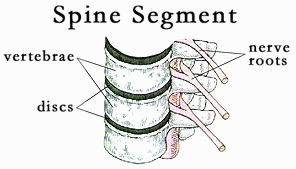
The
natural curves of the spine are vitally important
for giving your back strength and resilience. There
are 26 vertebrae in your spinal column. The lumbar
vertebrae are approximately two inches in diameter
reflecting their weight-bearing role. The cervical
vertebrae are smaller, since they must support only
the head. Facet joints are located in pairs on the
back of the spine, where one vertebra slightly overlaps
the next. The facet joints guide and restrict movement
of the spine. To the rear of each vertebra is a
hole and when the vertebrae are stacked up, these
holes form a continuous channel which holds the
spinal cord.
The spinal cord provides a vital link between the
brain and all body functions below the neck. Spinal
nerves emerge from the spinal cord through gaps
between the main body of the vertebrae and the facet
joints. One frequent cause of back pain is a worn
facet joint, which can result in a pinched nerve.
Therefore, it is very important to keep your vertebrae
in good shape. |
|
Today
back pain is one of the most common of all physical
complaints in the world. About 70 to 90% of men
and women in the U.S. have had or will have a least
one bout of incapacitating low back pain. Back pain
contributes to lost work time and may cost as much
as $100 billion annually (if lost productivity is
included).
Low
back pain can be acute or chronic, manifesting in
the lumbosacral region and associated musculoskeletal
structures. Low back pain is extremely prevalent.
Low back pain can become a life long struggle. When
performing even the simplest tasks of everyday life,
we may turn, twist, lift, and either push or pull
something the wrong way and be crippled with low
back pain that is constant and debilitating in nature.
Low back pain injuries may often be overlooked and
under diagnosed. Consequently, the injuries may
progress and delayed initiation of appropriate therapy
may prolong the treatment course. Low back pain
injuries may be as simple as muscle aches or as
severe as spinal cord paralysis from lumbar compression
secondary to osteoporotic fractures. Spinal decompression
is the way to reverse this problem and the best
technique known for accomplishing spinal decompression
is using an inversion table in the convenience of
your home. |
|
|
Back
pain in the lower back or low back pain is a common
concern, affecting up to 90% of Americans at some
point in their lifetime. Up to 50% will have more
than one episode. Low back pain is not a specific
disease. Rather, it is a symptom that may occur
from a variety of different processes. In up to
85% of people with low back pain, despite a thorough
medical examination, no specific cause of the pain
can be identified. |
• Low back pain is second only to the common
cold as a cause of lost days at work. It is also
one of the most common reasons to visit a doctor's
office or a hospital's emergency department.
• For 90% of people,
even those with nerve root irritation, their
symptoms will improve within 2 months, no
matter what treatment is used—even if no treatment
is given.
• Doctors usually refer to back pain as acute
if it has been present for less than a month and
chronic if it lasts for a longer period of time.
|
|
This
drawing shows a normal disc. The main function of
your discs is to act as shock absorbers and provide
separation between each vertebrae. The outer layers
of your discs are formed from tough cartilage. The
inner core of your disc is a jelly-like nucleus.
In total, your discs account for one-quarter the
length of your vertebral column- 4.50" to 6"
(12 to 15 cm) for most people. The
disc acquires its nourishment through fluid-attracting
and fluid-absorbing qualities of its jelly-like
nucleus. This is one reason using an inversion
table can be so beneficial in disc healing and regeneration.
The rocking motion is extraordinary in creating
an intermittent traction and compression that can
assist in the regenerative process. One reason discs
degenerate and and regenerate slowly is due to the
passive nature of the circulation to the ruptured
or compressed discs. Spinal
decompression is the way to reverse this
|
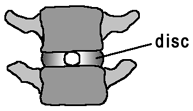 |
|
problem
and the best technique known for accomplishing spinal
decompression is using an inversion table in the
convenience of your home.
With no blood supply of its own, the disc is dependent
on sponge action for attracting and absorbing nutrients
from adjacent tissues. During non-weight bearing
activities (sleeping) the discs expand as they soak
up fluid, increasing the length of the spine by
as much as one inch overnight. During weight bearing
activities (sitting, standing, exercising), this
fluid is squeezed back into the adjacent soft tissue.
Low
back pain can range from acute to chronic. Ranging
from a dull, intermittent, nagging ache to an unbearable,
tear eliciting pain. |
|
Your
vertebra are supported and moved by many different
muscles. Muscles are used for three basic functions;
support, movement, and posture control. If muscles
are tight or weak, they create or worsen back pain.
Joints are controlled by at least two sets of muscles,
flexors which bend the joint, and extensors which
straighten it. In addition, most joints have rotator
muscles that twist and rotate your bones. Good posture
is only possible if the flexors, extensors, and
rotators are in proper balance. |

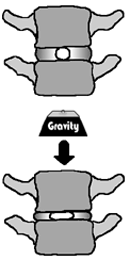
|
Your
paraspinal muscles (which run parallel to your spine)
rotate your spine, bend it backwards, and sideways,
and influence posture by creating and maintaining
the curves of your spine. Your erector spine muscles
are involved in movement and run the length of your
spine. These muscles help you to bend over by resisting
the force of gravity, and to straighten up by contracting
and exerting great compressive force on your spine.
Your abdominal muscles play an important role in
helping to support the spine by maintaining pressure
inside the abdomen. This pressure is an essential
measure of counter support to the spine. |
|
Understanding
the physiology responsible for the symptoms will
guide us in understanding the treatment. Most back
pain is caused by musculoligamentous strain, degenerative
disk disease, nerve impingement, sciatica, or arthritis
and responds to symptomatic treatment. Occasionally,
back pain may result from problems originating outside
the spinal axis. Serious underlying problems such
as tumor, infection, or vertebral compression must
be kept in mind. (1)
The perception of pain is experienced on an individual
basis, but the physiologic basis of pain receptors
are the same. Nociceptors are pain receptors of
the body. They are located all over the body and
maldistributed. The skin being largest organ and
also extremely sensitive, has the most nociceptors.
Impulses are generated by nociceptors, which travel
along the spinal cord and relay pain that is either
diffuse or localized. Fast pain travels through
the A Fibers along the neospinothalamic tract. A
Fibers produce pain that is sharp and well localized.
On the other hand, slow pain travels through C Fibers
along the paleospinothalanic tract producing pain
that is dull and aching in nature. (2) |
|
Your
psoas muscles (hip flexors) are a large group of
muscles in the abdomen. These muscles help to flex
your hips when walking or climbing stairs. They
play an important role in maintaining posture for
sitting and standing.
Intravertebral joints are supported by ligaments,
tough and inelastic fibers which support the spine
and hold it together by allowing only a limited
range of movement in any one direction. Ligaments
require regular movement and loading, otherwise
they will eventually become stiff and weak. Using
the inversion table can give an excellent controlled
workout to the muscles and ligaments necessary for
a healthy spine. |
|
The
etiology of the pain depends on the injury sustained.
Nerves, spinal cord, disks and vertebrae make up
the complex structure of the lower back. Muscles
and ligaments provide strength and power and at
the same time support and stability. Small joints
of the lower back allow functional movement and
further stability. The spinal cord and nerves are
the “electric cables” which travel through
a central canal in the lumbar vertebrae, connecting
your brain to the muscles of your legs. The five
lumbar vertebrae connect the upper spine to the
pelvis and sacrum. The disks, like shock absorbers,
act by both supporting and cushioning the lumbar
vertebrae. (3) |
|
We
need strong back, abdominal, and hip muscles to
resist gravity and to hold us up. Besides holding
us up they act to keep the spine and pelvis in alignment.
As societies around the world become more mechanized
and computerized, they have also become less exercised.
We lock ourselves behind desks and in front of computers.
When we sit, our back muscles hold us erect, but
our stomach and hip muscles are inactive. When they
are not exercised, stomach and hip muscles become
weaker, putting a painful strain on the back muscles.
Sitting places higher loads inside the lumbar disc
than standing (between 150% to 250% depending on
posture). |
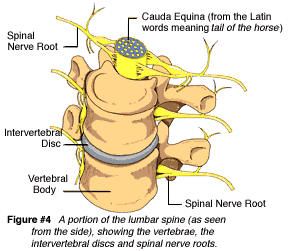 |
| To
understand spinal conditions, surgeries and procedures
- click here: |
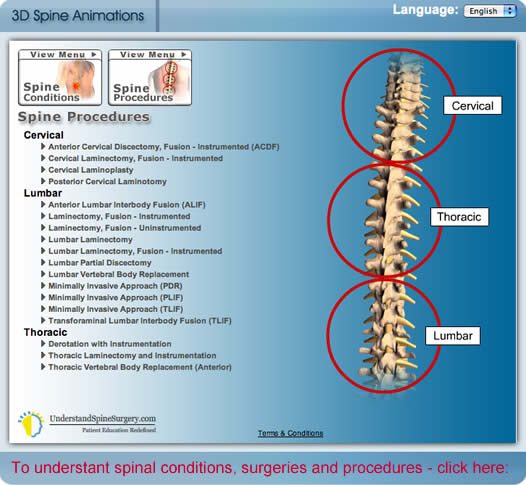 |
Compressed
Disc, Slipped Disc, Herniated Disc, Ruptured Disc,
Leading to a Pinched Nerve (nerve impingement) &
Sciatica |
|
A
ruptured disc in the back occurs when all or part
of the soft, gelatinous central part of the vertebral
disc is forced through the bones of the spinal column.
What is going on in the body? Sandwiched between
the vertebra of the spinal column are discs that
act like shock absorbers. A disc is made up of two
parts. The outer ring or annulus is a tough, fibrous
material. The inner part or nucleus is a soft, jelly-like
material. A ruptured disc occurs when the outer
ring tears or break, allowing the jelly-like material
to poke through the crack. This can result in pressure
on nerves, often causing pain. Sometimes leading
to sciatica & leg pain. The terms ruptured disc,
slipped disc & herniated are often used in the
same context. There is an enormous body of evidence
that a compressed disc, whether or not it is actually
ruptured can be aided by inversion
therapy. Inversion increases the intervertebral
space and allows the disc to return to is shock
absorber and spacer function. Spinal
decompression is the way to reverse this problem
and the best technique known for accomplishing spinal
decompression (reverse nerve impingement) is using
an inversion table in the convenience of your home.
|
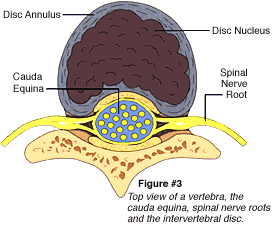
There
is an enormous body of evidence that
shows a compressed disc, ruptured
or not can often be aided by inversion
therapy. |
| Spinal
decompression is the way to reverse
these problems and the best technique
known for accomplishing spinal decompression
is using an inversion table in the
convenience of your home.
|
|
|
|
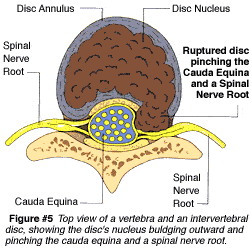 |
 |
| Inversion
Helps Improve Circulation and Accelerates the Cleansing
of Blood and Lymph Fluids |
| The
cardiovascular system is your body's transportation
system, carrying food and oxygen to your body's
cells. Oxygen-rich blood from the lungs travels
out through the arteries and waste-filled blood
comes back through the veins to be cleansed and
recharged with oxygen. Because your body must work
against gravity to retrieve blood from your legs
and lower torso, inversion can help to ease the
circulation process by placing your body in a position
that utilizes gravity's force in your favor.
Unlike the cardiovascular system, the lymphatic
system has no pump. Only the alternate contraction
and relaxation of muscles moves lymphatic fluid
through capillaries and one-way valves to the upper
chest for cleansing. Inverting the body so that
gravity works with, not against, these one-way valves
helps to push the fluid up to the chest.
In her book Beyond Cellulite,
Nicloe Ronsard discusses the role of the lymph system
in creating cellulite, and ways in which people
can help stimulate lymph flow to reduce cellulite.
She explains that when the flow of lymph is slowed
down, a stagnation of fluid occurs in the tissues.
In areas where circulation tends to be poor and
as in the hips and thigh area, this stagnation encourages
the formation of cellulite.
By reversing gravity's force on the flow of blood
and lymph fluids in the body, you can increase the
nourishment of cells and accelerate the removal
of wastes. The rocking motion
that is easy to do on the Teeter Hang Ups inversion
tables is excellent for stimulating lymph and blood
circulation. |
Piriformis
Syndrome |
|
Sciatica
caused by Piriformis Syndrome is only one of several
conditions that can cause sciatica which is the
pain you may feel in your hip, buttocks and going
down your leg. Usually it is felt on one side. Piriformis
Syndrome causes sciatica by irritating the sciatic
nerve which is the largest nerve in the body. The
nerve passes through the hip on the way down to
the foot. Piriformis Syndrome may be difficult to
diagnose because often the main cause of sciatica
is a compressed disc. This can usually be reversed
with the conservative use of an inversion table.
Most people who have sciatica will have one or more
conditions causing it. The compressed disc is one
and pelvic tilt leading
to Piriformis Syndrome is another. Often the muscles
that align the pelvis are out of balance leading
to a tilted pelvis and one leg being shorter than
the other. When this happens the path of the sciatic
nerve may be irritated when it comes in contact
with the Piriformis muscle. If disc compression
is not the problem or has been reversed and your
doctor feels mild exercise is appropriate these
three simple exercises may have a tremendously corrective
effect on the pelvic tilt issue that may causing
Piriformis Syndrome.
1. All Fours Leg Thrust
- Get on all fours like you are going to crawl.
Thrust out the right leg up and back & then
the left. You may want to do 10 reps with each leg.
It is good to vary the position of the foot so it
is sometimes perpendicular to the ground and sometimes
parallel to the ground. Start out with a mild workout
and if well tolerated work these muscles everyday
until they are quite strong.
2. Standing Leg Thrust
- This is a variation on All
Fours Leg Thrust. You can do this
standing. Hold on to a sturdy dresser or table about
waste or abdomen high. Lean forward and kick your
leg back and up as if you are trying to kick someone
directly behind you. It is good to vary the position
of the foot so it is sometimes perpendicular to
the ground and sometimes parallel to the ground.
Do an equal number of reps with each leg. Try if
you can to work up to the point that when you kick
your leg out it is parallel to the ground.
3. Stair Climbing
- Start gradually and work up to a 5-10 story building
2-4 times a week.
These exercises work directly on the gluteus maximus,
psoas and other muscles to help strengthen and balance
the muscles that if imbalanced can tilt the pelvis
and exacerbate compressed disc and irritated nerve
problems. |
Testimonial
To see more testimonials as to the benefits of inversion
therapy please click here: |
| Hi,
I'm just writing to say how
completely happy I am that I bought your F5000 Inversion
Table. I was having severe problems with
my back. A trip to the Dr. and ultimately an MRI
revealed I had severe calcium deposits (from arthritis)
built up around my sciatic nerve. This resulted
in my having to walk bent over
just to slightly reduce the severe pain I
was experiencing starting at the buttocks and going
all the way down to my ankles. I was really depressed
when my orthopedic Dr. was recommending I see a
spinal surgeon. After having surgery for both 2
hips and 2 knee replacements I
was not exactly enthused about the prospect of back
surgery. I told the Dr. I wasn't ready for
that option just yet cause my wife
had seen an article on Inversion Tables and how
they can help people with herniated discs and sciatic
problems. I was skeptical but when I saw
your free trial offer, I figured what have I got
to lose, so I bought the F5000 Inversion Table.
At first I didn't think it helped, however after
just 2 weeks use I could walk upright again and
have very little to no pain any longer. Don't
know how long this table will help me, but each
day I can put off back surgery I'm thankful for.
Feel free to use this testimonial.
I'm thankful I listened to
my wife and decided to try this table.
John A. Tisevich - 8/3/2003 |
Testimonial
To see more testimonials as to the benefits of inversion
therapy please click here: |
Sciatica
The sciatic nerves are the largest nerves
in the body - about as big around as your little
finger. They start in the lower spine, pass behind
the hip joint, and go down the buttock and back
of the leg to the foot. Pain from this nerve, called
sciatica (a
form of nerve impingement)
,
may be felt from the hip to the big toe. |
|
Along
with aging, most causes of low back pain are from
sprains and strains. These injuries are usually
from repetitive motions and lifting. Other causes
of low back are osteoathritis, muscle spasms and
sciatica (herniated disc). Metabolic bone disease,
such as osteoporosis can cause debilitating back
pain. Spine fracture from trauma, cauda equina syndrome
(spinal stenosis) spondylisis, ankylosing spondylitis,
benign and malignant metastatic tumors can also
cause low back pain. Infection, connective tissue
disorders, abdominal aortic aneurysms (AAA), hyperparathyroidism,
and nephrolithias are also considered possible causes
of low back pain. (4) |
|
What
causes sciatica?
Sometimes the nerve is pinched between
vertebrae, or its passageways are narrowed by arthritis
or swelling of a sprained ligament in the area,
and it becomes irritated and tender. A disk (the
cushion between the vertebrae) may bulge out of
place and press on the nerve (impingement)
. Rarely, an abscess, blood clot, or growth may
push on the nerve. At times, no exact cause is found,
but a movement that is normally harmless (such as
bending over) suddenly brings on violent pain. |
Is
sciatica different from other types of back pain?
Yes, although low back pain often comes
with it. Usually, sciatica affects only one side.
Pain often radiates down the buttock or leg. It
can range from a tingling, burning, pins-and-needles
feeling to excruciating, shooting pain that makes
standing up nearly impossible. Coughing, sneezing,
and sitting make the pain worse. Your leg or foot
may be numb or weak and have odd sensations in it.
You may be unable to move your foot or bend your
knee. Spinal
decompression is the way to reverse this problem
and the best technique known for accomplishing spinal
decompression (reverse nerve impingement) is using
an inversion table in the convenience of your home.
| In
most cases sciatica as well as cervical
disc compression is a mechanical problem.
Probably the best mechanical solution in
the world is an inversion table (hanging
at mild to moderate angles and including
some oscillation) along with an exercise
program (see below). This two prong approach
works to decompress the the discs which
may be desiccated (dried out) due to chronic
compression. And to balance out the muscle
strength in the front , back, left and right
sides of the pelvis to reduce pelvic tilt.
|
Our
company has been working with back pain
sufferers since 1980 and the feedback we
have received from the more than 12,500
people we have sold tables to are testimony
to how well inversion therapy works. |
Traction
was the therapy of choice by the medical
profession for hundreds if not thousands
of years. It is amazing how often they overlook
this simple therapy in this age of drugs
and surgery. |
Another
component of healing and regeneration is
nutrition. Our company has also been involved
in the field of nutritional supplements
for many, many years. There is a very compelling
argument made by researchers & nutritionists
that many if not most people are mineral
deficient. The bases for this claim is that
plants are grown with synthetic fertilizers
on mineral depleted soils. The best mineral
supplement we have ever found that has resulted
in improved health for thousands and thousands
of people is New
Vision's Essential Minerals. They are
derived from organic plants and have about
70 major and trace minerals that are easy
to absorb in a delicious lemon-lime drink.
For any health plan to be most effective
it is good to know that your basic nutritional
needs are covered. We would also recommend
New Vision's Essential
Calcium. |
|
To
learn more about sciatica, diagnosis
and treatment of piriformis syndrome
take a look at sciatica.org. |
|
|
 |
To
see an excellent YouTube video on disc compression
and disc degeneration click
here:
The video is demonstrating the Spine Med Decompression
system.
Inversion therapy accomplishes much the same. |
|
|
| Discs
are soft, rubbery pads between the hard bones
(vertebrae) of the spinal column. When they
are young and healthy, discs are plump with
water, which keeps them hydrated and they
have the perfect consistency to work as shock
absorbers for the vertebrae. They also act
to maintain the space between the vertebrae
so the nerves are not impinged upon. Over
time the daily stress of gravity, sitting,
twisting and the process of aging may dry
them out like grapes turned into raisins.
This is called desiccation. This disc desiccation
or drying out can be reversed and the disc
can be rehydrated.
As discs deteriorate, their tough outer shell
weakens. One swing on the tennis court or
lifting in the wrong way can burst the interior
gel through
the
caseing, like jelly squishing out of a doughnut.
|
|
act
as shock absorber and spacer. With mild inversion
the vertebrae
are separated allowing the discs to regain
their form and function. After the pressure
is taken off the nerve there can be a rocking
motion added to the inversion therapy.
The rocking motion creates an accordion like
pumping action that helps to hydrate and increase
the fluid circulation to the discs. It creates
a compression and expansion. One of the reasons
discs degenerate and don't regenerate well
is due to the passive nature of the fluid
flow to the discs. They are not vasuclarized
like a kidney. The fluid flow to and from
the disc is based on body movement such as
walking and breathing. The rocking motion
on the table facilitates this fluid flow as
good or better than perhaps any other activity.
|
|
The result is the infamous herniated disc
(also referred to as ruptured or slipped disc)
this leads to pressure
on the nerve also known as nerve impigement.
When a disc bulges against one of the two
sciatic nerves, which run from the spinal
cord down the legs, the pain can be excruciating.
This bulge can also take place in the cervical
area which affects the neck, shoulders, arms
and hands.
Inversion therapy adresses the duel function
of the discs, their ability to |
Disc
Desiccation and Diuretics for High
Blood Pressure - Water Pills |
We
have no way to verify this scientifically,
however, we have been working in the
field of back problems and inversion
therapy since 1980 and it has been
our observation that there may be
a correlation between diuretic therapy
and disc problems. Long term use of
diuretics to help control high blood
pressure may contribute to disc desiccation
which is described above. Most people
who have disc problems may
have one or two compressed, herniated
or ruptured discs. We have found people
who have disc problems and who are
on diuretics seem to be more likely
to have 3-4 or even more compressed
discs than the person who is not on
diuretics. Also when we hear someone
has sciatica on both sides, this is
often a sign to us they maybe on diuretics.
When people tell us they have 5 compressed
discs and we ask if they are on diuretics,
we are not surprised to hear that
they are. They are surprised when
we ask them the question because they
had never made the correlation before.
We have even spoken with nephrologists
(kidney and
blood pressure specialist) and they
had never made the correlation either
but believe there maybe be a causal
relationship.
To our knowledge we are the
first to make this observation.
If you are taking diuretics you should
be aware of this issue.
|
|
| |
|
EXERCISES - EXERCISES
-
EXERCISES
- EXERCISES
-
EXERCISES
|
Some
Things To Keep In Mind - EXERCISES
Remember many of our back & other problems are
due to gravity's chronic downward pull on our bodies.
Often causing COMPRESSED OR PINCHED NERVES leading
to SCIATICA. Hang Ups inversion
tables can assist in reversing this compression.
Also keep in mind that before surgery became so
popular for back problems TRACTION was the therapy
of choice. Gravity traction gives the user total
control and the results we have seen are impressive.
Along with INVERSION THERAPY we encourage people
to be sure they have bilateral symmetry in the muscle
strength that holds the pelvis & back in alignment.
Doing the exercised below may
help achieve this bilateral
symmetry. PELVIC
TILT is often a condition
that happens along with compressed discs and pinched
nerves. Often leading to one
leg being shorter than the other or exacerbating
a leg length difference. For example after some
trauma such as an auto accident the body goes into
a protective mode and certain muscles may tense
up. The pelvis may tilt left to right or front to
back or both. This tilt affects the entire alignment
of the spine. This alignment affects how the vertebra
may impinge on the nerves. Inversion can usually
increase the intervertebral space and relieve the
direct pressure on the nerve. But in order to get
a more complete correction the muscles that align
the pelvis must be equally balanced and strong on
both sides. There are many exercises that can assist
in this effort. Four (1, 2,
3 and 5) that we have found very beneficial
are:
1. All Fours Leg Thrust
- Get on all fours like you are going to crawl.
Thrust out the right leg up and back & then
the left. You may want to do 10 reps with each leg.
It is good to vary the position of the foot so it
is sometimes perpendicular to the ground and sometimes
parallel to the ground. Start out with a mild workout
and if well tolerated work these muscles everyday
until they are quite strong.
2. Standing Leg Thrust
- This is a variation on All
Fours Leg Thrust. You can do this
standing. Hold on to a sturdy dresser or table about
waste or abdomen high. Lean forward and kick your
leg back and up as if you are trying to kick someone
directly behind you. It is good to vary the position
of the foot so it is sometimes perpendicular to
the ground and sometimes parallel to the ground.
Do an equal number of reps with each leg. Try if
you can to work up to the point that when you kick
your leg out it is parallel to the ground.
3. Stair Climbing
- Start gradually and work up to a 5-10 story building
2-4 times a week.
These exercises work directly on the gluteus maximus,
psoas and other muscles to help strengthen and balance
the muscles that if imbalanced can tilt the pelvis
and exacerbate compressed disc and irritated nerve
problems.
4. Swimming
- This is a marvelous way to get good exercise that
is easy on the joints and can relax, strengthen
and balance the muscular system that aligns and
effects the spine. Sacroiliac
joint dysfunction which is different from
sciatica responds very well to swimming as well.
Sacroiliac is actually
a sacroiliacitis or
inflammation of the sacroiliac
joint. The sacroiliac joint connects the sacrum
(triangular bone at the bottom of the spine) with
the pelvis (iliac bone). It transmits all the forces
of the upper body to the pelvis and legs. There
is not a lot of motion in the joint and it is very
strong. Sometimes all it takes to create a sacroiliac
problem is to lift something the wrong way. Sacroiliac
tends to be a self limiting problem that usually
will self correct within a few weeks. After the
initial acute phase (where ice is recommended) a
great therapy is first relax in a hot tub then swim
for while.
5. Bike Riding
- Especially up hills. Regular bike riding works
mostly the calves and thighs. Although an excellent
exercise that may be quite beneficial for the body
in general and specifically good for movement in
the sacroilliac joint and circulation that may benefit
the discs - regular bike riding does not adequately
work the muscles that are needed in order to align
the pelvis. When you are working hard riding a bike
up hill or are in a high gear where you may need
to come off the seat you are then working the proper
muscles for bilateral symmetry & alignment.
These and other exercises
may not be possible until after using the inversion
table a while. Using the gravity traction properly
should increased the intervertebral space and relieve
the pressure on the nerve. Once the disc has had
the pressure relieved it can usually start to regain
is spongy shock abosorber properties and spacer
function. Then exercises such as these can be eased
into.
***
Don't Forget Low Back Support ***
|
Whether
you are sitting in a chair, driving your
car or on an airplane be sure to give your
low back strong support with a proper lumbar
supporting chair or a pillow. In an ideal
sitting position the lumbar arch should
be maintained. Allowing the shoulders to
come forward and the low back to sag puts
extra pressure on the lumbar region which
may exacerbate low back problems. According
to the Nachemson Study sitting in a chair
creates about 50% more intradiscal pressure
than standing upright. Also if back pain
is chronic your bed may be too soft. |
For
more in-depth study on back pain, sciatica,
scoliosis etc. see the research work of
Nachemson:
National Center for Biotechnology Information
U.S. National Library of Medicine
Click
Here |
|
Spinal
Stenosis |
We
have been in the inversion field since 1980
and have had many people tell us that the
inversion table has helped with their spinal
stenosis problem. It is a natural therapy
that gives the back movement and motion in
ways it may otherwise not be able to achieve.
It is very likely to help. Stenosis is a mechanical
problem in some respects and inversion therapy
is a mechanical solution. Often in the human
body calcification will take place because
of trauma or stasis. If a joint is immobile
a therapy that mobilizes, lubricates, stimulates
circulation and creates a rhythmic massage
may be of therapeutic benefit. One technique
many in the field believe is beneficial to
helping spinal stenosis and to heal and regenerate
the discs is to create a rocking motion. Often
done for a few minutes AFTER a 15-20 minute
inversion session at mild angles (coming up
every 5 minutes or so to horizontal for a
brief break from the traction). This rocking
motion done after the inversion session creates
a pumping action that facilitates circulation
to the disc tissue which is infused by movement
of the body. The rocking motion is done by
rocking back to a 45 degree angle or so then
rock forward so you are nearly upright then
rocking back again. Doing this for a minute
or so after a 15-20 minute inversion session
creates an accordion like pumping action that
many believe can speed the recovery of the
discs. This rocking motion is only recommended
when one has been using the table for at least
a week or two (or longer) and when pain symptoms
are NOT present. This rocking motion can create
moment within the vertebrae that may help
reverse the condition of spinal stenosis.
If calcium deposits and calcium precipitating
out of solution in the body and creating arthritic
changes are of concern you may want to read
this page on reversing arthritis and bone
spurs: Often arthritis, bone spurs and
spinal stenosis are a result of a chemical
imbalance in the body that can be addressed
nutritionally as well a mechanically. The
Traction
Handles which are standard on the Teeter
Hang Ups EP-950
Inversion Table, Power
Tables and can be an added feature on
the Teeter Hang Ups F9000
Inversion Table are excellent for stretching
and relaxing the spinal column. |
What
is spinal stenosis?
The term “stenosis” comes from
Greek and means a “choking”. Spinal
stenosis, however, has little in common with
choking. There are two primary types of spinal
stenosis:
• In lumbar spinal stenosis, the spinal
nerve roots in the lower back are compressed,
or choked, and this can produce symptoms of
sciatic pain -- tingling, weakness or numbness
that radiates from the low back and into the
buttocks and legs -- especially with activity.
• Spinal stenosis in the neck (cervical
stenosis) can be far more dangerous by compressing
the spinal cord itself and possibly leading
to major body weakness or even paralysis.
This is virtually impossible in the lumbar
spine, however, as the spinal cord is not
present in the lower lumbar spine. The true
spinal cord ends at approximately the L1 level,
where it divides into many different nerve
roots that travel to the lower body and legs.
This collection of nerve roots is called the
"cauda equina," which means horse's
tail and describes the continuation of the
nerve roots at the end of the spinal cord. |
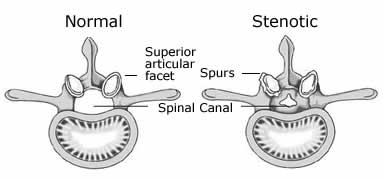
|
|
We
have had many many parents tell us that
the inversion table has helped with their
child's scoliosis. It a natural therapy
that gives the child's back an excellent
stretch. It is very likely to help. We have
also had many adults tell us the same thing
about their issue with curved spine problems.
Scoliosis is a mechanical problem and inversion
therapy is a mechanical solution. The Traction
Handles which are standard on the Teeter
Hang Ups EP-950
Inversion Table, Power
Tables and can be an added feature on
the Teeter Hang Ups EP-550
Inversion Table are excellent for stretching
and relaxing the spinal column. If you are
interested in medical research on scoliosis
therapy please
click here:
Inversion
Therapy and
Scoliosis |
Inversion
therapy is a safe, non-invasive
approach to treating scolosis in
a child or adult. As with all gravity
traction we advise a very conservative,
go slow, take it easy method you
can read about here: |
One
example of the many testimonials
about scoliosis we have received. |
Hi,
The pediatrician who had sent
our daughter to the Scottish Rite
hospital becasue she had a bit
of a curvature in her spine, saw
her for his referral last week.
He was amazed at how straight
her back was and asked her how
she did it. She said that when
she started using the inversion
table, that in just a few months
her shoulders were level and she
had no more trouble will ill-fitting
clothes due to one shoulder lower
than the other - great, huh!?
Martha Ylitalo - 4-15-04
|
If
you are thinking of having a Harrington
rod implantation surgery please
read: |
Every
year in the United States, roughly
20,000 Harrington rod implantation
surgeries are performed on patients
with scoliosis, at an average cost
of $120,000 per operation (2). One-third
of all spinal surgeries are performed
on scoliosis patients. Every year,
about 8,000 people who underwent
this surgery in their youth for
the correction of their scoliosis
are legally defined as permanently
disabled for the rest of their lives.
Even worse, follow-up x-rays performed
upon these individuals reveal that,
an average of 22 years after the
surgery was performed, their scoliosis
has returned to pre-operative levels
(3). The Harrington rods inserted
into these individuals’ spines
will either bend, break loose from
the wires, or worse, break completely
in two, necessitating further surgical
intervention and removal of the
rod. Once the rod is removed, corrosion
(rust) is found on two out of every
three (4). After the operation is
performed, the average patient suffers
a 25% reduction in their spinal
ranges of motion (5). Non-fused
adult scoliosis patients do not
have this same impairment. This
flatly contradicts the claim that
having a steel rod fused to your
spine will not affect your mobility,
physical activities, or quality
of life. These facts are never shared
with the patient prior to the surgery.
Parents do not choose the Harrington
rod implantation procedure because
it is the best choice for their
son or daughter, but rather because
they are misled into believing that
it is the only choice. However,
many studies
suggest that the side effects of
the surgery are worse than the side
effects of the scoliosis itself.
Our thanks to scoliosis-treatments.com
|
|
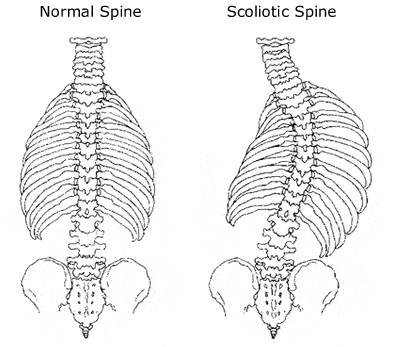
|
| To
see a short YouTube video - What Is Scoliosis? Please
click here: |
 |
Everyone's
spine has natural curves. These curves round our
shoulders and make our lower back curve slightly
inward. But some people have spines that also curve
from side to side. Unlike poor posture, these curves
can't be corrected simply by learning to stand up
straight.
This condition of side-to-side spinal curves is
called scoliosis. On
an x-ray, the spine of a person with scoliosis looks
more like an "S" or a "C" than
a straight line. Some of the bones in a scoliotic
spine also may have rotated slightly, making the
person's waist or shoulders appear uneven.
We have found in working with doctors & their
patients for more than 20 years that inversion therapy
can be a great adjunct in the treatment of scoliosis.
In children as well as teens and adults the symptoms
associated with scoliosis in many many cases are
reduced when a person receives the benefits of gravity
traction. In conjunction with stretching, exercises
and inversion therapy we have also taken note of
the benefits of daily deep muscle massage. Thismay
be achieved with an electronic massager such as
the Massage
Mat with Far Infrared Neck Pillow. Also if muscles
are particularly affected and a doctor is advised,
in many cases a moist heat hydrocollator can be
of great benefit.
We have had reports from people who have used gravity
inversion therapy for scoliosis and reduced pain
symptoms in their lower backs they had previously
accepted as chronic and intractable. They did not
correlate these symptoms with the scoliosis
but when they achieved benefits from the gravity
inversion therapy they started for scoliosis a side
or direct benefit was a relief from chronic low
back pain that had become so common that they did
not even realize how uncomfortable it was until
it disappeared.
Can inversion help children
with scoliosis? Does age matter?
Our medical advisor prefers to get
patients involved with inversion as early as possible.
Using inversion to help slow or reverse the effects
of scoliosis is helpful at any age, but especially
before the bones fully harden
at ages 12-14. The size of the equipment may be
an issue, so younger children will need an attendant.
Children love inversion and many many scoliosis
patients report excellent results after starting
inversion therapy. It is a great way for parents
to get involved in assisting their child. Also don't
forget to be sure your child has excellent nutritional
support. Three fantastic supplements
that are great for anyone are
New Vision's Essential Minerals, Essential Calcium
& Essential Vitamins.
There are many causes of scoliosis. Some causes
may be problematic for inversion (bone infection,
cancer, compression fracture). Most scoliosis in
children is related to bone anomalies or calcification
disorders, both of which do well with inversion.
Of course, if you have any doubt, you should always
consult with a licensed physician.
We
have found the stretch and straightening
of inversion therapy to be beneficial
in working with people with scoliosis.
Many physicians who use inversion
therapy recommend getting patients
involved while they are still young
and bones have not fully matured.
Here are some useful links if you
would like to learn more about scoliosis: |
I-Scoliosis
Scoliosis
Research Society
Amazon
Scoliosis Reading List
 |
Excellent
nutrition is of course important
in trying to prevent or correct
a musculoskelital problem. The best
calcium supplement we have found
is Essential
Calcium. Nutritious, delicious
and easy to take as a sparkling
beverage. And to be sure the body
has the proper mineral balance we
recommend the best selling liquid
mineral supplement in North America
- Essential
Minerals. |
|
|
Before
starting
any exercise or therapeutic program it is recommended
you check with your doctor and begin any new activity
very gradually. In rare instances back pain is
a symptom of a serious medical condition such
as a kidney tumor or cancer. Even medical doctors
sometimes make this mistake. We have seen cases
of people being medicated for back pain when the
actual problem was more serious. PLEASE BE AWARE
|
Summary
| • |
There
are 26 vertebrae in your back which encase
your spinal cord.
In childhood there are 33 vertebrae they
fuse into 26. 7 cervical,
12 thoracis, 5 lumbar, 1 sacral (5 fused
into one bone, the sacrum) and 1 coccygeal
(4 fused into one bone the coccyx). |
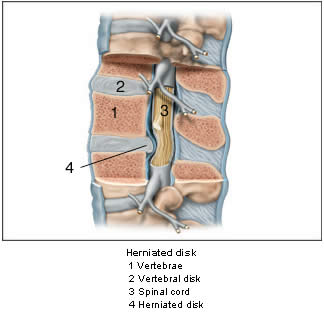 Your
23 discs act as shock absorbers.
Your
23 discs act as shock absorbers.
If they are compressed the nerves can be
pinched. Traction had been the treatment
of choice before pain relieving drugs and
surgery came into common use. The benefits
of decompressive traction are accomplished
easier with an inversion table than perhaps
any other known method. |
| • |
Spinal
nerves run through each vertebral joint
in your spinal column. |
| • |
There
are 23 intervertebral discs. With no blood
supply of their own, discs depend on sponge-like
action to soak up nutrients and eliminate
waste products. |
| • |
Many
doctors believe rhythmic intermittent traction
which is easy to do with an inversion table
by creating a simple rocking motion may
facilitate disc healing and regeneration.
The pumping action of traction and compression
may speed up the healing process. |
| |
| • |
Muscles
and ligaments require regular movement in
order to maintain flexibility. |
| • |
An
imbalance or weakness in the strength of
the muscles can affect the alignment of
the spine & pelvis. A bilateral imbalance
in this muscle strength (often the gluteus
maximus) can lead to a tilting of the pelvis
& nerve pain. |
| • |
The
combination of proper exercise, nutrition
and inversion therapy can greatly improve
the quality of our general health and especially
reduce or reverse previously intractable
back problems. |
| |
| |
| |
|
|
|